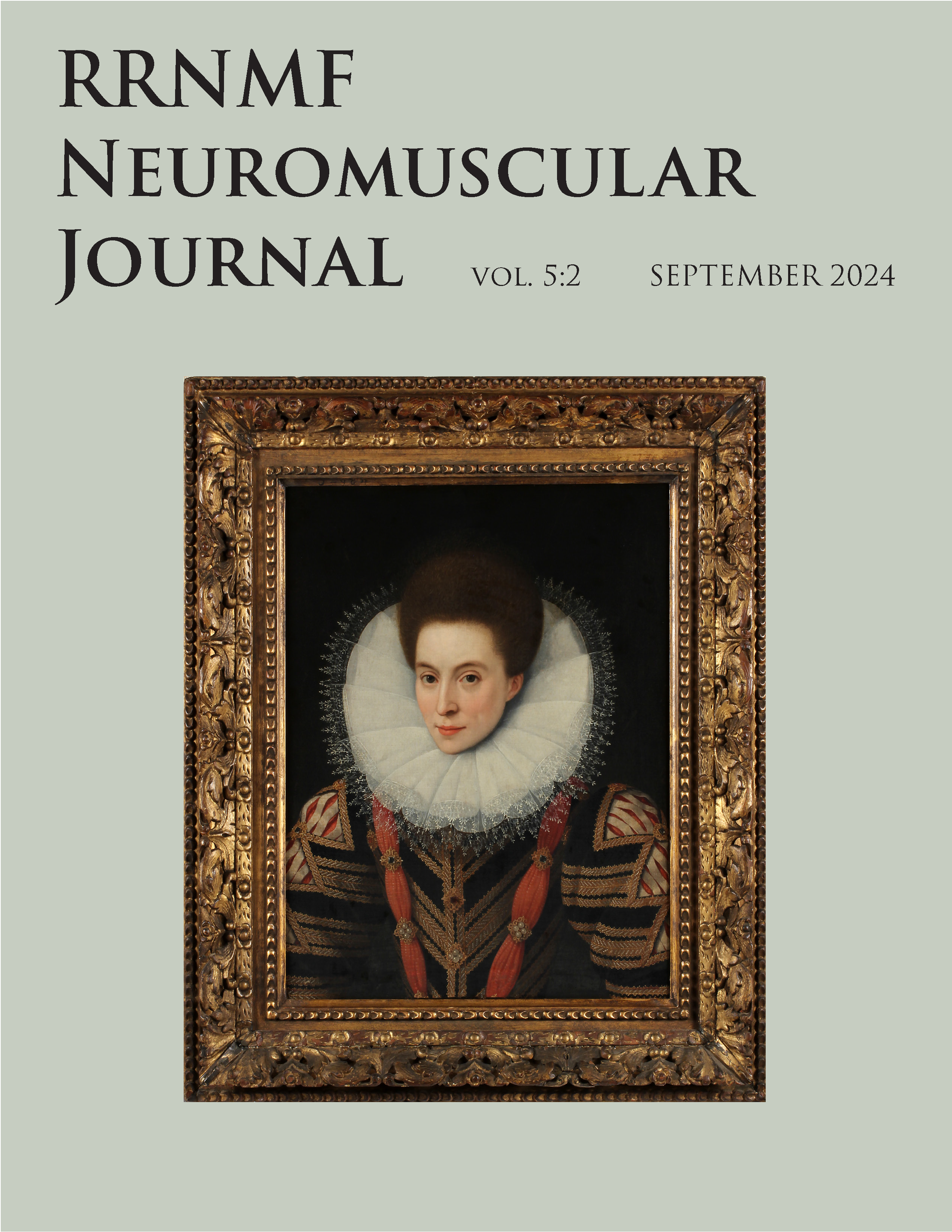Successful recovery of anti-SRP myopathy with subcutaneous methotrexate after 17 years of poor response to immunomodulation
DOI:
https://doi.org/10.17161/4sj8y833Keywords:
myopathy, anti-SRP myopathy, methotrexate, Muscle MRIAbstract
An 18 year old woman presented with a year of progressive proximal limb weakness. Serum creatine kinase (CK) was elevated and electromyography suggested an irritable myopathy. Muscle biopsy revealed severe, chronic, active, necrotizing myopathy. Myositis-specific autoantibodies were initially negative; however, an immune-mediated necrotizing myopathy was suspected. She had only minimal response to variable immunomodulatory therapies over 17 years, with progression of weakness. Subsequent repeat testing confirmed positive anti-Signal Recognition Particle (SRP) autoantibodies. A thigh MRI, 17 years after symptom onset, showed extensive fatty replacement and significant muscle atrophy, suggesting a low likelihood of response to further immunosuppression. Nonetheless, motor function significantly improved after initiation of subcutaneous methotrexate (MTX). She has been stable off immunosuppressive therapy for 4.5 years. This report exemplifies that a protracted clinical course, extensive fatty replacement and atrophy on muscle MRI and normal CK levels do not preclude a late response to immunomodulatory therapy in anti-SRP myopathy.
Downloads
References
Kassardjian CD, Lennon VA, Alfugham NB, Mahler M, Milone M. Clinical Features and Treatment Outcomes of Necrotizing Autoimmune Myopathy. JAMA Neurol 2015;72:996-1003.
Watanabe Y, Uruha A, Suzuki S, et al. Clinical features and prognosis in anti-SRP and anti-HMGCR necrotising myopathy. J Neurol Neurosurg Psychiatry 2016;87:1038-1044.
Kamperman RG, van der Kooi AJ, de Visser M, Aronica E, Raaphorst J. Pathophysiological Mechanisms and Treatment of Dermatomyositis and Immune Mediated Necrotizing Myopathies: A Focused Review. International journal of molecular sciences 2022;23.
Allenbach Y, Mammen AL, Benveniste O, Stenzel W. 224th ENMC International Workshop:: Clinico-sero-pathological classification of immune-mediated necrotizing myopathies Zandvoort, The Netherlands, 14-16 October 2016. Neuromuscul Disord 2018;28:87-99.
Pinal-Fernandez I, Casal-Dominguez M, Mammen AL. Immune-Mediated Necrotizing Myopathy. Curr Rheumatol Rep 2018;20:21.
Binns EL, Moraitis E, Maillard S, et al. Effective induction therapy for anti-SRP associated myositis in childhood: A small case series and review of the literature. Pediatric rheumatology online journal 2017;15:77.
Kawabata T, Komaki H, Saito T, et al. A pediatric patient with myopathy associated with antibodies to a signal recognition particle. Brain Dev 2012;34:877-880.
Luca NJ, Atkinson A, Hawkins C, Feldman BM. Anti-signal recognition particle-positive juvenile polymyositis successfully treated with rituximab. J Rheumatol 2012;39:1483-1485.
Merlonghi G, Antonini G, Garibaldi M. Immune-mediated necrotizing myopathy (IMNM): A myopathological challenge. Autoimmun Rev 2022;21:102993.
Pinal-Fernandez I, Parks C, Werner JL, et al. Longitudinal Course of Disease in a Large Cohort of Myositis Patients With Autoantibodies Recognizing the Signal Recognition Particle. Arthritis care & research 2017;69:263-270.
Pinal-Fernandez I, Casal-Dominguez M, Carrino JA, et al. Thigh muscle MRI in immune-mediated necrotising myopathy: extensive oedema, early muscle damage and role of anti-SRP autoantibodies as a marker of severity. Ann Rheum Dis 2017;76:681-687.
Xiong A, Yang G, Song Z, et al. Rituximab in the treatment of immune-mediated necrotizing myopathy: a review of case reports and case series. Ther Adv Neurol Disord 2021;14:1756286421998918.
Zheng Y, Liu L, Wang L, et al. Magnetic resonance imaging changes of thigh muscles in myopathy with antibodies to signal recognition particle. Rheumatology (Oxford, England) 2015;54:1017-1024.
Wang L, Liu L, Hao H, et al. Myopathy with anti-signal recognition particle antibodies: clinical and histopathological features in Chinese patients. Neuromuscul Disord 2014;24:335-341.
Downloads
Published
Issue
Section
License
Copyright (c) 2024 Yohei Harada, Debra Guntrum, Aravindhan Veerapandiyan, Alexis Lizarraga, Andrew Mammen, David Herrmann

This work is licensed under a Creative Commons Attribution-NonCommercial-NoDerivatives 4.0 International License.

